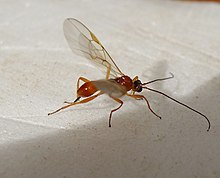en
names in breadcrumbs

The Euphorinae are a large subfamily of Braconidae parasitoid wasps. Some species have been used for biological pest control. They are sister group to the Meteorinae.
Euphorines are small, usually dark colored wasps. They are non-cyclostomes. Euphorines are found worldwide.[1]
Euphorines are solitary or rarely gregarious koinobiont endoparasitoids. Unlike most other parasitoid wasps, Euphorinae have a broad host range and attack adult insects or nymphs of hemimetabolous insects.
Wasps of the tribe Dinocampini parasitize adult beetles.[2] Its four genera are Dinocampus Foerster, Ropalophorous Curtis, Centistina Enderlein, and Betelgeuse.[2]
Representative tribes of Euphorinae are Centistini, Cosmophorini, Cryptoxilonini, Dinocampini, Euphorini, Helorimorphini, Meteorini, Myiocephalini, Oncometeorini, Perilitini, Proclithrophorini, Syntretini, and Tainitermini.
These 36 genera belong to the subfamily Euphorinae:
Data sources: i = ITIS,[3] c = Catalogue of Life,[4] g = GBIF,[5] b = Bugguide.net[6]
 Pygostolus
Pygostolus The Euphorinae are a large subfamily of Braconidae parasitoid wasps. Some species have been used for biological pest control. They are sister group to the Meteorinae.